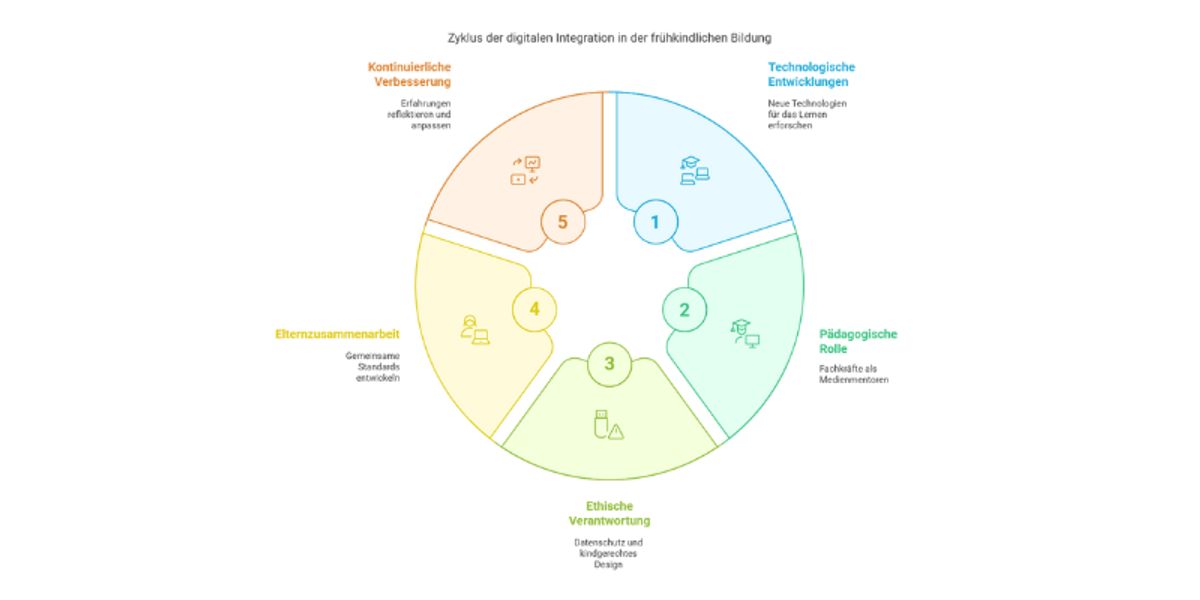Introduction
In conclusion, we take a deeper look into the future: How could digital media be used in nursery and preschool settings as today’s children grow older? Which technological trends are emerging – and how can we shape them responsibly and in a child-friendly way? One thing is clear: digitalization continues to advance. In early childhood education, the question is not if, but how digital elements can be meaningfully integrated without compromising the foundation of child development.
1. Technological Developments
Interactive whiteboards and learning robots: In some kindergartens, these already support playful learning, language development, or scientific curiosity. In nurseries, however, their age-appropriateness must be questioned. Technological tools should never replace real-life experiences but can be used selectively – for example, to support observation or documentation. A robot-based "greeter" or a talking digital photo frame might accompany social rituals but should never replace real interaction.
VR and AR in preschool: Virtual excursions or augmented reality (AR) can provide stimulating learning experiences – such as a virtual trip to a farm or the forest. For children under the age of three, however, extreme caution is advised. Sensory overload or lack of real-world context can easily overwhelm. Future research must clarify how and when such technologies can be used developmentally appropriately.
Digital voice assistants or AI-powered storybooks: Early prototypes show how stories can be personalized via voice recognition. But we must ask: do they truly support children’s language development – or do they replace the central role of human interaction?
2. The Role of Educators
Educators as media mentors: The role of childcare professionals will continue to evolve. They need not only digital pedagogical knowledge but also a clear stance: When does a medium add value? When does it interfere with development? Reflective thinking is key to integrating new technologies thoughtfully into educational practice.
Ongoing training and guidelines: Institutions must ensure regular training so that teams stay up to date. Shared reflection sessions where digital tools are reviewed and discussed are also essential. National guidelines can provide orientation, but implementation should be tailored to each setting’s concept.
Partnership with parents: Families also face challenges in handling digital media. Educators can act as a bridge, working with parents to develop shared standards – for screen time, content selection, and role-model behavior.
3. Ethical Responsibility
Data protection and privacy: Each new app, platform, or cloud solution raises questions about data: What is stored? For how long? Who has access? Especially in early education, strict data protection policies must be observed and communicated transparently. Parents should always know what data is collected and how it is used.
Child-friendly technology design: Developers, educators, and parents must work together to ensure that digital offerings are age-appropriate, easy to understand, and low in sensory overload. An app that supports children’s self-efficacy is far more valuable than one that encourages passive consumption. The child’s perspective should always come first – not technological trends.
Enabling digital participation: A responsible approach to technology also means preparing children for a digital world – through first, safe, guided experiences. Media literacy doesn’t begin in school – it starts in early childhood education, always adapted to age and development.
Conclusion
Digitalization will continue to shape early childhood education. The challenge is to strike a thoughtful balance: Which technologies are truly appropriate for young children? How can we integrate digital tools in a way that supports learning without displacing the essence of early childhood – play, movement, and relationships? It is important that educators avoid both tech enthusiasm and skepticism and instead ask: What benefits the child?
Series Summary
Digitalization is part of our everyday lives – even in early childhood. Its use should always be measured, reflective, and responsible.
- In organizational areas – such as documentation and parent communication – digital tools offer many benefits, as long as data protection is ensured.
- In media use with children, real sensory, movement, and relationship experiences must always take precedence. Digital media may provide occasional value but must never replace real interaction.
- Future developments will bring new opportunities – but also raise ethical and pedagogical questions, especially in terms of developmental psychology.
- Parent and public engagement should include digital topics more actively, helping reduce uncertainty and promote mindful media use.
Ongoing professional development, team collaboration, and a mindset of attentiveness are crucial to ensuring that digitalization becomes a true asset in nursery life – for children, educators, and families alike.
This concludes our four-part series on “Digitalization in Everyday Nursery Life.” We hope it has provided valuable inspiration for your educational practice – and, as always, we welcome your feedback, questions, and real-life stories from your nursery!
